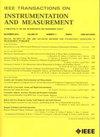Reduction of Dynamic Spatial Distortion of Miniaturized Streak Tube Using Deflection Compensation Technique
IF 5.6
2区 工程技术
Q1 ENGINEERING, ELECTRICAL & ELECTRONIC
IEEE Transactions on Instrumentation and Measurement
Pub Date : 2024-10-23
DOI:10.1109/TIM.2024.3485443
引用次数: 0
Abstract
In miniaturized streak tube (MST), the scanning electric field, while deflecting dynamic imaging, inevitably causes dynamic spatial distortion (DSD), declining dynamic spatial resolution (DSR) uniformity and hindering large-area applications. To mitigate these cases, a compensation system has been devised, aiming to reduce DSD and enhance DSR uniformity by the application of the falling edge of V-shaped high-voltage pulse (VHVP). The research results demonstrate the VHVP, featuring a rising edge slope of 12.68 kV/ns and a falling edge slope of 15.22 kV/ns, which successfully generated by the Marx circuit combined with the LC filter. When the VHVP, in conjunction with the deflection compensation technique (DCT), was implemented in the MST, a notable reduction in DSD was achieved. Specifically, within a利用偏差补偿技术减少微型化条纹管的动态空间失真
在微型条纹管(MST)中,扫描电场在偏转动态成像的同时,不可避免地会造成动态空间失真(DSD),降低动态空间分辨率(DSR)的均匀性,妨碍大面积应用。为了缓解这些情况,我们设计了一种补偿系统,旨在通过应用 V 型高压脉冲(VHVP)的下降沿来减少 DSD 并提高 DSR 的均匀性。研究结果表明,VHVP 的上升沿斜率为 12.68 kV/ns,下降沿斜率为 15.22 kV/ns,由 Marx 电路与 LC 滤波器结合成功产生。当 VHVP 与偏转补偿技术(DCT)结合在 MST 中实施时,DSD 显著减少。具体来说,在 30 毫米的检测区域内,DSD 比率从 35.61% 降至 12.09%,同时在离轴 15 毫米处,DSR 一致性提高了 5.45%。此外,对比分析表明,与利用弯曲阴极和球形荧光屏(PS)实现 2.31% 改进率的 $\Phi 16$ -mm 检测面积的 MST 相比,所提出的 DCT 在 8 mm 离轴点上实现了 17.36% 的显著改进率。这些发现为从技术上提高 MST 性能提供了一种通用而有效的方法。
本文章由计算机程序翻译,如有差异,请以英文原文为准。
求助全文
约1分钟内获得全文
求助全文
来源期刊

IEEE Transactions on Instrumentation and Measurement
工程技术-工程:电子与电气
CiteScore
9.00
自引率
23.20%
发文量
1294
审稿时长
3.9 months
期刊介绍:
Papers are sought that address innovative solutions to the development and use of electrical and electronic instruments and equipment to measure, monitor and/or record physical phenomena for the purpose of advancing measurement science, methods, functionality and applications. The scope of these papers may encompass: (1) theory, methodology, and practice of measurement; (2) design, development and evaluation of instrumentation and measurement systems and components used in generating, acquiring, conditioning and processing signals; (3) analysis, representation, display, and preservation of the information obtained from a set of measurements; and (4) scientific and technical support to establishment and maintenance of technical standards in the field of Instrumentation and Measurement.
 求助内容:
求助内容: 应助结果提醒方式:
应助结果提醒方式:


